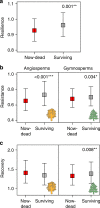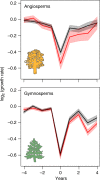Low growth resilience to drought is related to future mortality risk in trees
- PMID: 31992718
- PMCID: PMC6987235
- DOI: 10.1038/s41467-020-14300-5
Low growth resilience to drought is related to future mortality risk in trees
Abstract
Severe droughts have the potential to reduce forest productivity and trigger tree mortality. Most trees face several drought events during their life and therefore resilience to dry conditions may be crucial to long-term survival. We assessed how growth resilience to severe droughts, including its components resistance and recovery, is related to the ability to survive future droughts by using a tree-ring database of surviving and now-dead trees from 118 sites (22 species, >3,500 trees). We found that, across the variety of regions and species sampled, trees that died during water shortages were less resilient to previous non-lethal droughts, relative to coexisting surviving trees of the same species. In angiosperms, drought-related mortality risk is associated with lower resistance (low capacity to reduce impact of the initial drought), while it is related to reduced recovery (low capacity to attain pre-drought growth rates) in gymnosperms. The different resilience strategies in these two taxonomic groups open new avenues to improve our understanding and prediction of drought-induced mortality.
Conflict of interest statement
The authors declare no competing interests.
Figures



References
-
- Bonan GB. Forests, climate, and public policy: a 500-year interdisciplinary Odyssey. Annu. Rev. Ecol. Evol. Syst. 2016;47:97–121. doi: 10.1146/annurev-ecolsys-121415-032359. - DOI
-
- FAO. Food and Agriculture Organization of the United Nations. Global Forest Resources Assessment 2015. How are the world’s forests changing? (FAO, 2016).
-
- Houghton RA, Nassikas AA. Negative emissions from stopping deforestation and forest degradation, globally. Glob. Chang. Biol. 2017;38:42–49. - PubMed
MeSH terms
Substances
LinkOut - more resources
Full Text Sources

